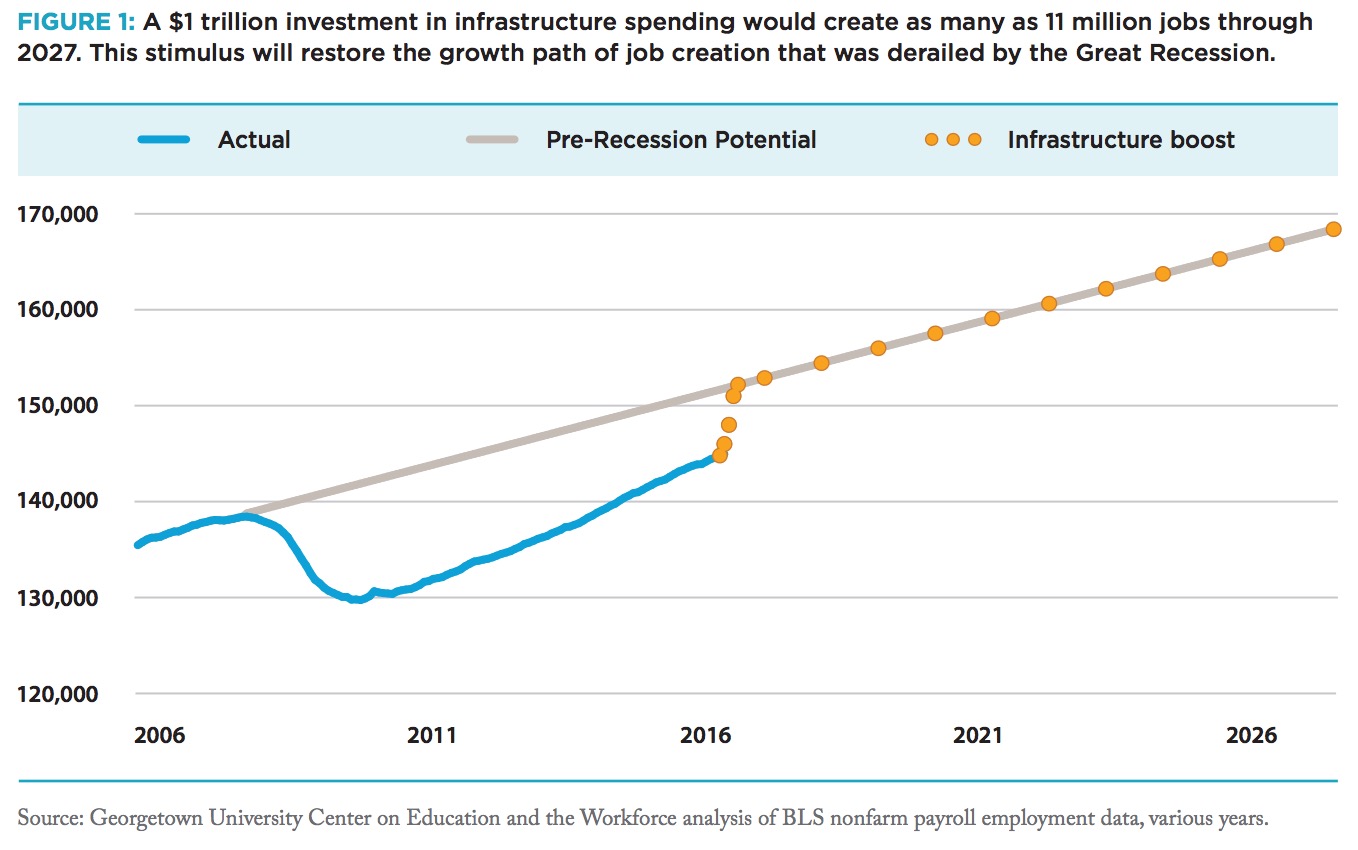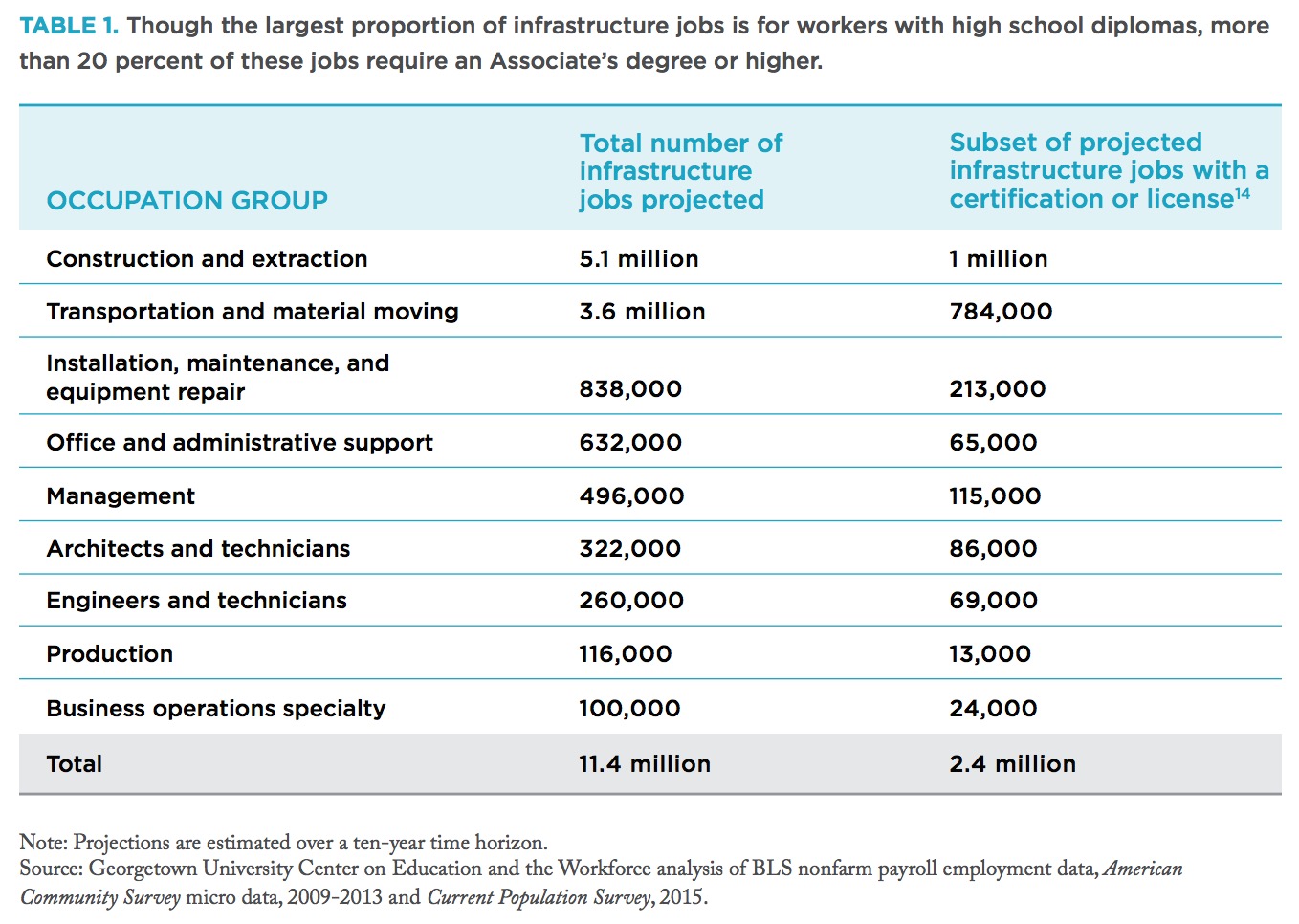GEORGETOWN UNIVERSITY
CENTER ON EDUCATION & THE WORKFORCE
Trump’s Infrastructure Proposal Could Create 11 Million Jobs – Will the New Jobs Lead to Sustainable Careers?
By Anthony P. Carnevale and Nicole Smith
President-elect Trump has proposed to spend up to $1 trillion over the next 10 years on America’s infrastructure, including transportation, energy, telecommunications, and border security.
The significant spending increase envisioned in President-elect Trump’s proposal raises concerns about inflation and interest rate hikes but would also create millions of new jobs. If enacted, the infrastructure program could put the United States back on a pre-recession job growth path and create more than 11 million jobs.
These jobs will consist of both those directly related to infrastructure — including jobs for tradesmen, construction workers, and material moving and transportation workers — as well as downstream jobs only somewhat related to infrastructure, such as in offices and retail services. Infrastructure-related jobs, which now comprise 12 percent of jobs in the U.S. economy, would temporarily increase to 14 percent of jobs.
Moreover, the President-elect’s proposal would revive, at least temporarily, the blue-collar economy. This would be a marked shift in the recent trajectory of the workforce.
In the peak years of the post–World War II blue-collar economy in the 1970s, 72 percent of jobs required no more than a high school education. Today, only 34 percent of existing jobs in the economy require a high school diploma or less. President-elect Trump’s proposal would temporarily increase jobs that require high school or less by 6.3 million jobs.
More than half (55 percent) of the new infrastructure jobs would go to high school graduates and high school dropouts, especially men in blue-collar occupations, who have been left behind due to economic changes over the past several decades. Almost 60 percent of the new infrastructure jobs would require at most six months of formal and informal on-the-job training. A full 16 percent of new jobs would likely go to high school dropouts, who are disproportionately of Hispanic/Latino ethnicity. Eighteen percent of the new jobs would likely go to Associate’s and Bachelor’s degree-holders, who are disproportionately white.
Slightly less than half (45%) of the new infrastructure jobs would require at least some college education and training, including jobs for civil engineers and construction managers. These training and education requirements would create new opportunities and new challenges for the nation’s secondary and postsecondary education and training system, especially for community colleges. 
Here is what a $1 trillion investment in infrastructure might mean for the job picture overall:
- An infrastructure investment of $1 trillion would create more than 11 million jobs over the next 10 years. These jobs would be a combination of the 6.4 million missing jobs that were not created as a result of the Great Recession (2007-09) and an additional 5 million jobs created as a result of the stimulus effect of the new infrastructure in related industries.
- The new infrastructure investment would wipe away the aggregate job losses of the Great Recession and put the United States back on the job growth trajectory that existed before the recession (Figure 1).
- Infrastructure jobs comprise 12 percent of the jobs in the U.S. economy. The new stimulus would temporarily increase infrastructure jobs to 14 percent of all jobs.
- Construction and extraction occupations, and transportation and material moving occupations will account for the vast majority of new infrastructure jobs (Table 1).
- The majority (92 percent) of newly created infrastructure jobs would be for men (Figure 5), given the historically male-dominated employment in infrastructure occupations, especially in transportation and construction (Table 1).
- While the construction and transportation industries would lead the way in job creation, many jobs would also be generated in management and white-collar office occupations, particularly for workers with an Associate’s degree or higher (Figure 3).
- Hispanic/Latino workers are disproportionately located in infrastructure jobs that require a high school diploma or less, while white workers are disproportionately concentrated in infrastructure jobs that require an Associate’s degree or higher (Figure 7).
- Hispanics/Latinos and blacks/African Americans working in infrastructure have relatively lower levels of educational attainment and thus stand to benefit from increased formal and informal training opportunities (Figure 7).
- Certifications for welders, concrete strength-testing technicians, construction managers, and construction health and safety technicians are in-demand credentials (Table 1 and Table 3).
Download full version (PDF): Trump’s Infrastructure Proposal Could Create 11 Million Jobs
About the Georgetown University Center on Education & the Workforce
cew.georgetown.edu
The Georgetown University Center on Education and the Workforce is an independent, nonprofit research and policy institute affiliated with the Georgetown McCourt School of Public Policy that studies the link between education, career qualifications, and workforce demands.
Tags: Center on Education & the Workforce, Donald Trump, Georgetown University, Trump, Trump Administration







 RSS Feed
RSS Feed